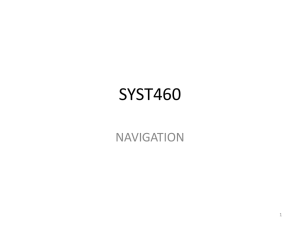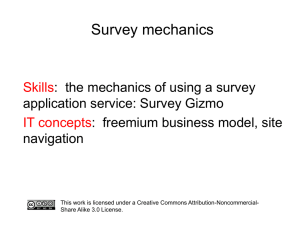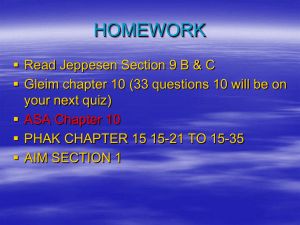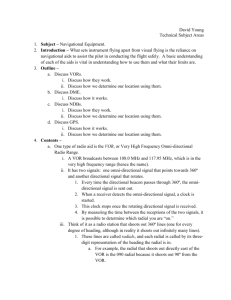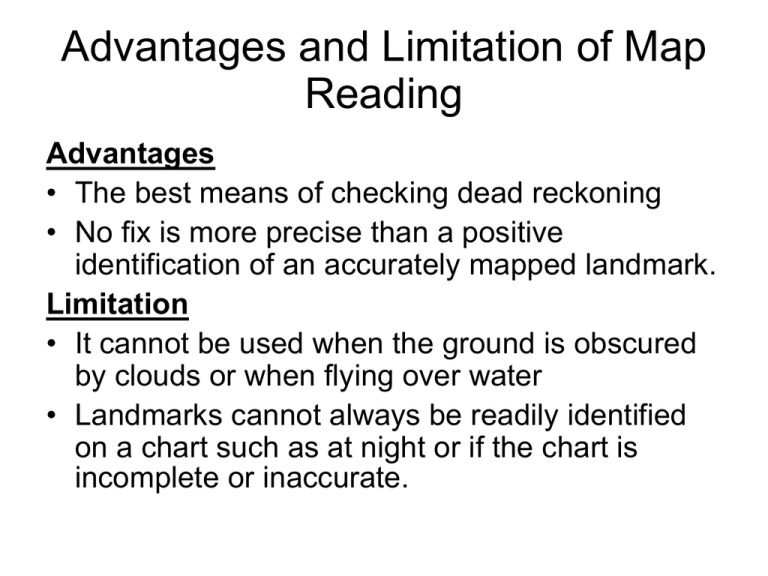
Advantages and Limitation of Map
Reading
Advantages
• The best means of checking dead reckoning
• No fix is more precise than a positive
identification of an accurately mapped landmark.
Limitation
• It cannot be used when the ground is obscured
by clouds or when flying over water
• Landmarks cannot always be readily identified
on a chart such as at night or if the chart is
incomplete or inaccurate.
Section B
VOR Navigation
VERY HIGH FREQUENCY
OMNIDIRECTIONAL
RANGE
VOR
Navigation
VOR Stations
Magnetic
North
360°
270°
180°
Jeppesen Sanderson, Inc. 1998 All Rights Reserved
Guided Flight Discovery Private Pilot Manual
090°
VOR Facilities
Standard High
Altitude Service
Volume
60,000 ft
100 n.m.
45,000 ft
130 n.m.
18,000 ft
18,000 ft
14,500 ft
100 n.m.
40 n.m.
1,000 ft
Standard Low
Altitude Service
Volume
Standard Terminal
Service Volume
12,000 ft
40 n.m.
1,000 ft
25 n.m.
1,000 ft
Jeppesen Sanderson, Inc. 1998 All Rights Reserved
Guided Flight Discovery Private Pilot Manual
VOR Ground
Equipment
40 Miles
Line of
Sight Limited
One Degree Accuracy
VOR Airborne
Equipment
33 0
30
27
24
21
3
6
9
18 15 12
120.70
121.90
112.60
113.0
VOR Navigation
Procedures
Station Identification
• __... __.__ __.__
• .__.__ … .__..
• __.__. __ __ .__
BKK
PSL
CMA
• CTR
• STN
• HTY
__.__. __ .__.
… __ __.
…. __ __.__ __
VOR Navigation
Procedures
Interpreting The
Indications
360
320
180
180
270
180
270
270
Jeppesen Sanderson, Inc. 1998 All Rights Reserved
Guided Flight Discovery Private Pilot Manual
Interpreting VOR Indications
Orientation and Bracketing
What happens at station passage?
Jeppesen Sanderson, Inc. 1998 All Rights Reserved
Guided Flight Discovery Private Pilot Manual
30
33
27
24
21
VOR Navigation
Procedures
Tracking A
What heading
Course/Radial
0
3
6
18
15
9
12
should be flown to
get back on
course?
150 Radial
VOR Navigation
Procedures
Tracking A
Course/Radial
33 0
30
27
24
3
6
21
330 Crs To
9
18 15 12
Learn to Bracket
VOR Navigation
Procedures
Tracking A
Course/Radial
33 0
30
27
3
24
6
21
9
18 15 12
330 Crs To
Learn to Bracket
Fly Hdg 310
30
33
27
24
21
VOR Navigation
Procedures
Tracking A
0 Course/Radial
330 Crs To
3
6
18
15
9
12
Wait to Center
Learn to Bracket
Fly Hdg 310
30
33
27
24
21
VOR Navigation
Procedures
Tracking A
0 Course/Radial
330 Crs To
3
6
18
15
9
12
Fly Hdg 320 to Crab
Wait to Center
Learn to Bracket
Fly Hdg 310
30
33
27
24
21
VOR Navigation
Procedures
Tracking A
0 Course/Radial
330 Crs To
3
6
18
15
9
12
Monitor and Adjust
Fly Hdg 320 to Crab
Wait to Center
Learn to Bracket
Fly Hdg 310
VOR Intercepting (Inbound course)
• The minimum acceptable angle of intercept for an inbound
course interception must be greater than the number of
degrees the aircraft is displaced from the desired course.
• The angle of intercept should not exceed 90º
VOR Navigation
Procedures
Intercepting A
Course/Radial
Identify the
Station
•
• Set in Desired Course
33 0
30
27
24
21
3
6
9
18 15 12
VOR Navigation
Procedures
Intercepting A
Course/Radial
Identify the
Station
•
• Set in Desired Course
• Parallel Desired Course
Fly Hdg 330
33 0
30
27
24
21
3
6
9
18 15 12
VOR Navigation
Procedures
Intercepting A
Course/Radial
Identify the
Station
•
• Set in Desired Course
• Parallel Desired Course
• Determine Amount Off Course
25 deg?
40 deg?
33 0
30
27
24
21
3
6
9
18 15 12
•
•
•
•
•
•
VOR Navigation
Procedures
Intercepting A
Course/Radial
Identify the
Station If over 30 deg, use 90
deg intercept angle.
Set in Desired Course
If 30 deg or less, use
Parallel Desired Course 45 deg intercept.
Determine Amount Off Course
30
27
Angle Towards the Needle
24
Wait to Center
33 0
21
3
6
9
18 15 12
•
•
•
•
•
•
•
VOR Navigation
Procedures
Intercepting A
Course/Radial
Identify the
Station
Set in Desired Course
Parallel Desired Course
Determine Amount Off Course
30
27
Angle Towards the Needle
24
Wait to Center
21
Begin Tracking
18
33 0
3
6
9
15 12
Intercept Heading (Inbound)
•
•
•
•
Desired Course 360, Present Course 030
Desired Course 090, Present Course 030
Desired Course 180, Radial 020
Desired Course 270, Radial 040
045º
360º
225º
180º
Error
• Desired course – หัวเข็ม ± 30º
• 30º จาก Desired course และถูกต้ องเมื่อ มุมระหว่ าง Desired
course และ หัวเข็ม ไม่ เกิน 30º
• Desired course 360º, Present course 070 – Make sense?
VOR Intercepting (Outbound course)
• To avoid overshooting, an intercept angle greater than 45º
should not be used.
• หาง – D ± 45º
Intercept Heading (Outbound)
•
•
•
•
Desired Course 360, Radial 030
Desired Course 090, Radial 030
Desired Course 180, Radial 200
Desired Course 270, Radial 220
315º
135º
135º
315º
VOR Navigation Procedures
Cross-Checking Your Position
VOR Navigation Procedures
Checking Equipment Accuracy
•
•
•
•
Ground Checks
Air Checks
Dual Check
Visual Check
33 0
30
27
3
24
6
21
9
18 15 12
VOR Navigation Procedures
Airborne VOR Test
Jeppesen Sanderson, Inc. 1998 All Rights Reserved
Guided Flight Discovery Private Pilot Manual
• If TO/FROM indicator is To, turn left or right?
• If your aircraft flies heading 150º, turn left or right?
33 0
30
27
24
21
3
6
9
18 15 12
VOR Navigation Procedures
Why Do Pilots Love The
DME?
Instant Distance
Instant Ground Speed
Instant ETA
Instant Location
VOR Navigation Procedures
Slant Range Distance
Jeppesen Sanderson, Inc. 1998 All Rights Reserved
Guided Flight Discovery Private Pilot Manual
Section C
NDB Navigation
NDB Ground
Equipment
Not Line of
Sight Limited
Pilot-Dependant Accuracy
NDB Airborne Equipment
(ADF)
ADF
201
USE
ADF BFO
FRQ
FRQ
263
STBY
F/E
S/R
Jeppesen Sanderson, Inc. 1998 All Rights Reserved
Guided Flight Discovery Private Pilot Manual
Radio Magnetic Indicator
(RMI)
A
F
B
E
C
D
Jeppesen Sanderson, Inc. 1998 All Rights Reserved
Guided Flight Discovery Private Pilot Manual
NDB Navigation
Procedures
Station Identification
Use REC mode to test/swing the needle.
Press to
Toggle
REC
ADF
ADF
201
USE
ADF BFO
FRQ
FRQ
263
STBY
F/E
S/R
NDB Navigation Procedures
Interpreting The Indications
B
A
D
C
E
F
G
NDB Navigation Procedures
Interpreting The Indications
A
B
C
D
E
F
G
NDB Navigation Procedures
Homing To The Station
NDB Navigation Procedures
Homing To The Station
Jeppesen Sanderson, Inc. 1998 All Rights Reserved
Guided Flight Discovery Private Pilot Manual
NDB Navigation Procedures
Tracking A Course/Bearing
REMEMBER!
NDB Navigation Procedures
Tracking A Course/Bearing
• Are you holding heading steady?
• Do you have a crab angle set in?
• Does the crab angle match the
pointer deflection?
• Is the pointer stationary?
• GOOD JOB!
NDB Navigation Procedures
Tracking A Course/Bearing
NDB Navigation Procedures
Tracking A Course/Bearing
• Turn 20 degrees towards
the pointer.
NDB Navigation Procedures
Tracking A Course/Bearing
• Turn 20 degrees towards
the pointer.
NDB Navigation Procedures
Tracking A Course/Bearing
• Turn 20 degrees towards
the pointer.
• Wait for 20 deg of pointer
deflection.
NDB Navigation Procedures
Tracking A Course/Bearing
• Turn 20 degrees towards
the pointer.
• Wait for 20 deg of pointer
deflection.
• Take out 10 deg and watch
for pointer movement.
NDB Navigation Procedures
Tracking A Course/Bearing
• Turn 20 degrees towards the
pointer.
• Wait for 20 deg of pointer
deflection.
• Take out 10 deg and watch
for pointer movement.
• Bracket further if necessary.
NDB Navigation Procedures
Intercepting A Course/Bearing
•
•
•
•
•
•
Reset Heading Indicator
Tune/Ident/Test
Parallel Course
Decide on Intercept Angle
Fly Intercept Angle
Wait for Intercept Angle to
Equal Pointer Deflection
• Begin Tracking
ADF Limitations
Pilot-Dependant Accuracy
ADF Limitations
Pilot-Dependant Accuracy
ADF Limitations
Pilot-Dependant Accuracy
ADF Limitations
Pilot-Dependant Accuracy
ADF Limitations
Pilot-Dependant Accuracy
For operations off established airways at 17,000 feet MSL in the
contiguous U.S.,(H) Class VORTAC facilities used to define a direct
route of flight should be no farther apart than
A-75 NM
B-100 NM
C-200 NM
VOR Facilities
Standard High
Altitude Service
Volume
60,000 ft
100 n.m.
45,000 ft
130 n.m.
18,000 ft
18,000 ft
14,500 ft
100 n.m.
40 n.m.
1,000 ft
Standard Low
Altitude Service
Volume
Standard Terminal
Service Volume
12,000 ft
40 n.m.
1,000 ft
25 n.m.
1,000 ft
Jeppesen Sanderson, Inc. 1998 All Rights Reserved
Guided Flight Discovery Private Pilot Manual
Where can the VOT frequency for a particular airport be found?
A-On the IAP Chart and in the Airport/Facility Directory
B-Only in the Airport/Facility Directory
C-In the Airport/Facility Directory and on the A/G Voice
Communication Panel of the en route Low Altitude Chart
Where does the DME indicator have the greatest error between
ground distance to the VORTAC and displayed distance?
A-High altitude far from the VORTAC
B-High altitude close to VORTAC
C-Low altitude far from the VORTAC
How should a pilot determine when the DME is inoperative?
A-The airborne DME will always indicate “0” mileage
B-The airborne DME will “search”, but not “lock on”
C-The airborne DME will may appear normal, but there will be no
code tone
Which DME indication should you receive when you are directly over
a VORTAC site approximately 6,000 feet AGL?
A-0
B-1
C-1.3
To minimize DME slant range error, how far from the facility should
you be to consider the reading as accurate?
A-Two miles or more for each 1,000 feet of altitude above facility
B-One or mor miles for each 1,000 feet of altitude above facility
C-No specific distance is specified since the reception is line-of-sight
When making an airborne an VOR check, what is the maximum
allowable tolerance between the two indicators of dual VOR system
(units independent of each other except antenna)?
A-4° between the two indicated bearings of a VOR
B-Plus or minus 4° when set to identical radials of a VOR
C-6° between the two indicated radials of VOR
To minimize DME slant range error, how far from the facility should
you be to consider the reading as accurate?
A-Two miles or more for each 1,000 feet of altitude above facility
B-One or mor miles for each 1,000 feet of altitude above facility
C-No specific distance is specified since the reception is line-of-sight
What angular deviation from a VOR course centerline is represented
by a full-scale reflection of the CDI?
A-4°
B-5°
C-10°
When using VOR for navigation, which of the following should be
considered as station passage?
A-The first movement of the CDI as the airplane enters the zone of
confusion
B-The moment the TO-FROM indicator becomes blank
C-The first positive, complete reversal of the TO-FROM indicator
A VOR receiver with normal five-dot course sensitivity shows a threedot deflection at 30 NM from station. The aircraft would be displaced
approximately how far from the course centerline ?
A-2 NM
B-3 NM
C-5 NM
Determine the approximate time and distance to a station if a 5°
wingtip bearing change occurs in 1.5 minutes with a true airspeed of
95 knots
A-16 minutes and 14.3 NM Time In Minutes = Seconds / Degrees Change
B-18 minutes and 28.5 NM Distance = Minutes x TAS / Degrees Change
C-18 minutes and 33.0 NM
Question ?

